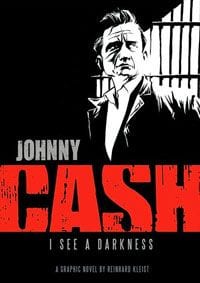
Reinhard Kleist’s Johnny Cash: I See a Darkness is a graphic, somewhat fictionalized biography of “the man in black”. The book breaks no new ground biographically, and one might even fault it for its romanticized dark focus (clear in the title) at the expense of sundry other details and important passages in Cash’s life, but it does make a visual artistic contribution and add some key details that other accounts (even a recent biopic) lacks.
Johnny Cash: I See a Darkness was originally published in German in 2006, and has taken three years to be translated and published in English. The translation is strong overall, though a handful of passages make the close reader balk at attempts to produce Southern, rural, blue-collar dialogue. Take for example the narrator’s colloquial style punctuated by “ya” and “cuz” contrasted with more educated constructions and non-contractions that hardly seem consistent.
A reviewer struggles for criteria to judge a work like this. How complete should the biographical side be? How entertaining the dialogue? What does the illustrative side add?
Most of Cash’s biographies (including his own autobiographies) are over 300 pages long. Kleist’s book, weighing in at 221 pages and of course with very little text on most pages (none at all in the last 15), doesn’t aim to be a comprehensive biography, but the question of why certain events and aspects get covered while others remain absent is unavoidable.
One marked difference in Kleist’s treatment of Cash, besides his illustrations, is that he frames the biographical narrative in one major event in Cash’s life: his encounter with inmate Glen Sherly, whose song “Gray Stone Chapel” Cash played and recorded at Folsom prison, and who serves as a kind of narrator from the book’s very beginning. Yet, Kleist still chooses a set of narrative events quite similar to recent pop culture treatments such as the film Walk the Line. The reader accompanies Cash through a briefly treated childhood, emphasizing hard work, hard times, the death of his brother, and a love of music, through his move north to Detroit factory life, to the army, before settling in Memphis with is first wife while he played music and worked as an unsuccessful door-to-door salesman.
All of that gets 20 pages, while practically the rest of the book is devoted to Cash’s amphetamine addiction, touring, and near fatal self-destructiveness, while the unwaveringly supportive, confident and beautiful June Carter endures these seemingly God-ordained trials of her will. Cash’s first wife and children are almost completely absent. It ends with a consideration of Cash’s now famous American Recordings produced by Rick Rubin. Kleist provides a slight twist on the traditional linear narrative by interjecting illustrative interpretations of well-known Cash songs such as “Boy Named Sue”.
The Man in Black comes off a bit underdeveloped as a character or life (whether you look at it as docu-fiction or biography). The struggles he had as a parent and his devout but troubled Christianity, for example, get only mild suggestions in Kleist’s treatment, just as they received no attention in the Hollywood film staring Joaquin Phoenix (despite the impeccable acting).
Unlike the recent popular film treatment, Kleist’s book gives attention to important and controversial aspects of Cash’s life, such as his championing of Native American causes (signified by his song “The Ballad of Ira Hayes”). Kleist’s account also shows a bit more the side of Cash revealed in his signature song “The Man in Black”, who wears the color for the poor and beaten down, livin in the hopeless hungry side of town”. So, too, is Cash’s concern with redemption nicely depicted, obvious in his desire to perform before prison audiences.
Kleist does better than the popular film but not nearly as well as the major already extant biographical accounts on these more commercially controversial aspects of the legend (which may simply be the limitations of this illustrative form). However, like some other accounts, Kleist’s ends up romanticizing Cash a bit, sympathetically depicting a troubled but strong soul.
The illustrations are the best aspect of this book. Cash the badass, self-destructive, often-loner with a buried heart comes out well in the grimaces and squints, gait and grin. Kleist’s careful brush convincingly captures the creepy crawly feeling of flesh sautéed in amphetamines, which is one of the book’s indisputable highlights, as is his rendering of Cash’s vision of ghost riders in the sky. Ghastly cowboys ride demonic fire-maned horses, condemned to eternally pursue fire-snorting steers across the horizon in a rodeo nightmare, of which Cash, in a lapse of faith perhaps, momentarily imagines himself a part.
At other times, neither the illustrations nor the narration or dialogue leaves much of an impression, and those acquainted with Cash will cavalierly pass from illustration to illustration, page to page, as they would while disinterestedly skimming the pictures of a magazine at the doctor’s office, just to pass the time. What is more, Cash’s illustrated face seems to oscillate in its resemblance to actual photographs of the man.
In sum, Kleist’s book serves to rehearse well-known stories and songs from Cash’s life-oeuvre, which in itself will be pleasurable for the devout fan. Beyond the difference of having illustrations, while other books just have photos, what Kleist achieves in some passages is a more expressionistic interpretation of key moments in Cash’s life, made more memorable by a sporadically gifted brush.

![Call for Papers: All Things Reconsidered [MUSIC] May-August 2024](https://www.popmatters.com/wp-content/uploads/2024/04/all-things-reconsidered-call-music-may-2024-720x380.jpg)



